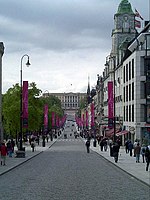Grand Hotel (Oslo)

Grand Hotel is a hotel in Oslo, Norway. The hotel is best known as the annual venue of the winner of the Nobel Peace Prize. Grand Hotel is situated in a very central location on the main thoroughfare, the Karl Johans gate, between the Norwegian Parliament building and the Royal Palace. It is within walking distance of Oslo's main shopping and cultural areas, as well as its sights. The hotel was opened in 1874 and is one of the most traditional hotels in Norway.Each year the hotel hosts the annual Nobel Peace Prize banquet, and the prize winners stay in the Nobel suite at the hotel. Roald Dahl stayed here when young and where his inspiration came from to do his 1984 autobiographical book, Boy: Tales of Childhood. The hotel has several restaurants. These include "Grand Café", where Henrik Ibsen used to eat every day; the "Restaurant Julius Fritzner", named after Julius Fritzner, the man who founded the hotel in 1874; and "Palmen Restaurant", a traditional and stylish lunch restaurant.Grand Hotel is a classical style building with white granite facade and clock tower. The hotel has 290 rooms. The hotel is affiliated with Rica Hotels, a chain of approx. 90 hotels located in Norway and Sweden.
Excerpt from the Wikipedia article Grand Hotel (Oslo) (License: CC BY-SA 3.0, Authors, Images).Grand Hotel (Oslo)
Karl Johans gate, Oslo Sentrum
Geographical coordinates (GPS) Address External links Nearby Places Show on map
Geographical coordinates (GPS)
| Latitude | Longitude |
|---|---|
| N 59.91373 ° | E 10.739572 ° |
Address
Grand Hotel
Karl Johans gate
0026 Oslo, Sentrum
Norway
Open on Google Maps









